|
Albatros D.V Diorama
by John
Reid
|
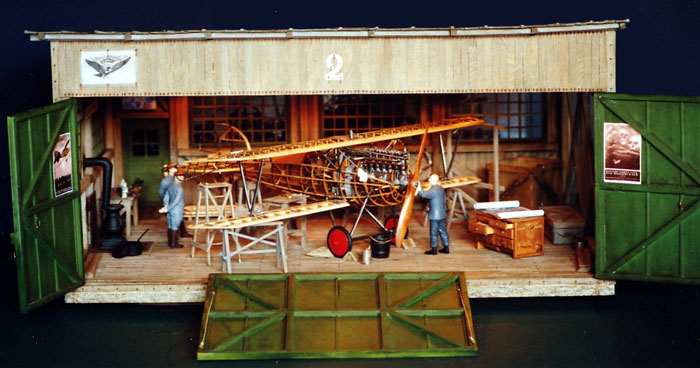 |
|
Albatros D.V Diorama |

HyperScale is proudly supported by
Squadron
The Idea
Somewhere in Germany 1918, the German Imperial Aviation Service has
decided to have the Red Knights old Albatros re-engined and recovered.
Corporal Schultz is testing the oil system for leaks after having
hand-swung the prop of the gleaming new Mercedes 180 hp engine. Both the
pilot and chief mechanic seem quite satisfied with the progress so far...
Questions, Questions, Questions
Somewhere in Montreal, eighty two years later, I am sitting in my workshop
wondering how I can pull this little scenario off. I know Model Expo has
a 1/16 Albatros model on the market but is it too large? How big a
diorama would I have to build? What about the 1/16 scale figures? Where
can I find all the research material? These and a hundred other questions
popped into my mind.
Then I thought, why not make the hangar one self-contained unit acting as
its own dust-proof case. I could open up the sides, the roof, and set the
windows in plexiglass, thus allowing the scene to be viewed from all
angles. I then searched for the 1/16 scale figures and found that both
Tamiya and Dragon had many action figures available. I would however have
to demote Field Marshall Rommell and put him in the Air Force and in the
wrong war (hope he doesn’t mind). The World War II Luftwaffe figure
became a World War I pilot and a German Infantry figure became the
mechanic with oily rag in hand.
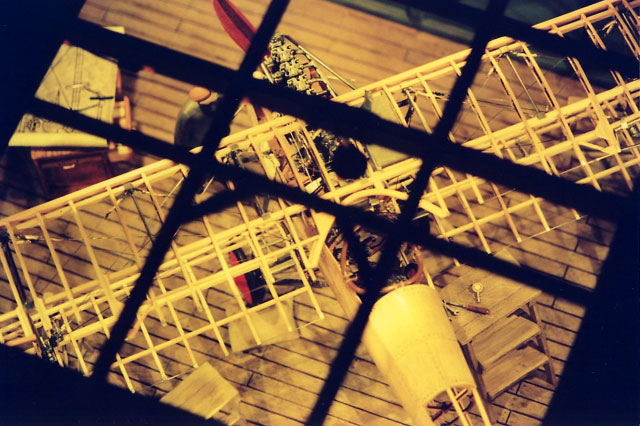
Now, on to the model’s workshop contents. While I could easily build the
furniture from scratch, what about the tools, lathe, oil and gas cans,
etc.? Doll house manufacturers sell many of these items in 1/12 scale and
tools come in various sizes therefore the difference in scale was not a
concern.
That being settled, it was on to the hangar.
How would I build it? Of course it would be made of wood, but where would
I find all the miniature lumber without it costing me a fortune? Then my
coffee habit finally paid off. Why not use wooden coffee stir sticks and
maybe tongue depressors too? The local building supply store would
provide the scale pine lumber for the studs and trusses. Problem solved.
And so it went two retirement years and 1500 hours of shop time later and
the project was finally completed.
The Aircraft - The Kit
Model Expo’s Albatros D.V (MA1001) comes in a well packaged, sturdy
cardboard box. The contents are well identified in individual plastic
packets. The miniature lumber quality is excellent as are the laser cut
parts on the plywood boards. The 47 page instruction booklet and 6 plan
sheets are very well done but they do need a lot of careful study. The
illustrations are clear, however, I do differ with the order in which the
aircraft is constructed. They recommend building the wings and stabilizer
first. I did the fuselage first. I find that having the fuselage
completed gives me an added incentive to go on during the not so
interesting tasks, such as building up the wing ribs, etc.
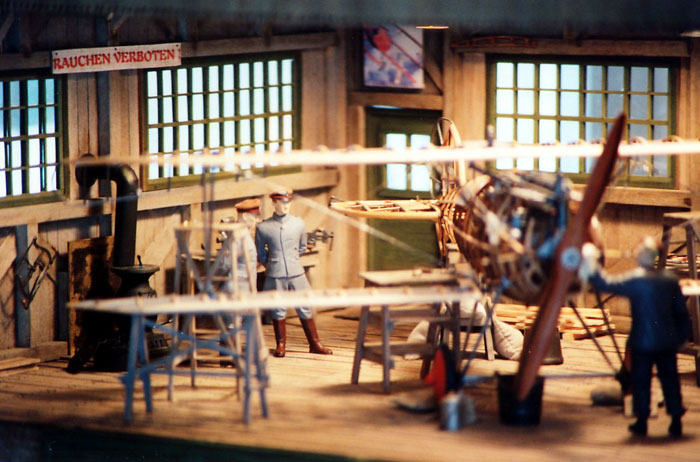
A lot of time was spent cleaning up the Britannia castings. Some of them
were slightly bent and there was some pitting and rough spots on the
metal. With careful re-alingning, filling with epoxy paste and sanding
smooth, the problem was soon remedied. The only real problem was with the
turnbuckles since many of mine were poorly cast. I probably got a bad
batch.
The instructions suggest using the kit supplied metal colored thread for
all the rigging. I, however, replaced this thread with .006 mm diameter
music wire.
The fuselage is built on a kit supplied jig. Construction is easy if you
follow the steps carefully. No major problems were encountered in fitting
any of the wooden parts together. I used both wood glue and super glue.
Some filing was required on the metal parts in order to make everything
fit together properly.
If you want to stain the wood, I recommend that you do it before
assembly. In fact, I even stained and sealed the wooden wing ribs before
removing them from their laser-cut plywood boards. I used an
alcohol-based permanent tan colored stain, Primacolor PM-70 (sand). I
then spray lacquered the wood using Watco brand semi-lustre.
The wings and stabilizer went together easily by carefully following the
plans.
The Mercedes 180 hp, 6 cylinder engine, is a kit in itself with over one
hundred Britania castings. I did however find some of these parts a
little difficult to handle, such as installing the small springs to the
rocker boxes. Other than the usual de-burring of parts, the engine went
together with super glue and five-minute two part epoxy.
All the metal parts throughout the aircraft were degreased, sealed and
primed before painting. I used Windex ammonia window cleaner as a
degreaser. It is important to remove any residue mold release agent (used
during the manufacturing process) or any oil from your hands. I sealed
the metal using spray lacquer or brushed it on using a solution of 2/3
laquer and 1/3 laquer thinner mixed in a small jar.
I sprayed or brushed on a thinned down coat of Gesso over the laquer (50%
water 50% Gesso). Gesso provides a good tooth for paint to adhere to and
has been used by artists and craftsmen for centuries. I use the Liquitex
brand 5308, available in any art supplies store.
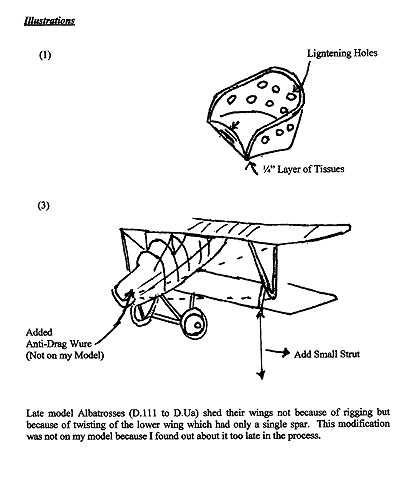 I
made my own pilot’s seat from 1/32 plywood. I bore out lightening holes
in the back of the seat and made a seat cushion out of Kleenex tissues. I
took a stack of tissues about ¼” thick, drew the seat pattern on the
tissues and cut it out with an x-acto knife. Using a mix of 25%
carpenter’s glue and 75% water, I soaked the seat cushion thoroughly and
then put it in the microwave oven for approximately 30 seconds. The
cushion puffed up into a nice looking seat which I then painted to look
like leather (Ill. 1). I
made my own pilot’s seat from 1/32 plywood. I bore out lightening holes
in the back of the seat and made a seat cushion out of Kleenex tissues. I
took a stack of tissues about ¼” thick, drew the seat pattern on the
tissues and cut it out with an x-acto knife. Using a mix of 25%
carpenter’s glue and 75% water, I soaked the seat cushion thoroughly and
then put it in the microwave oven for approximately 30 seconds. The
cushion puffed up into a nice looking seat which I then painted to look
like leather (Ill. 1).
 There
is one area at the bottom of both forward cabane struts that I thought
looked bad. I found them to be obviously out of scale, so I covered these
areas with oil stained rags made out of the glue and water soaked
tissues. I drapped these tissue rages so that they look weighted and
dried them in place using a hair dryer (Click the thumbnail to view
Illustration 2). There
is one area at the bottom of both forward cabane struts that I thought
looked bad. I found them to be obviously out of scale, so I covered these
areas with oil stained rags made out of the glue and water soaked
tissues. I drapped these tissue rages so that they look weighted and
dried them in place using a hair dryer (Click the thumbnail to view
Illustration 2).
The Albatros D.V is well represented in this kit with only two areas in
question. The kit was missing a small auxiliary strut that goes from the
leading edge of the lower wing and then back to the forward inter plane
strut. The other is in the rigging (Ill. 3). There seems to be another
anti-drag wing wire going from the nose of the fuselage to the top of the
outer wing interplane strut.
Because the aircraft in the diorama is being depicted as “under
construction”, the amount of details you put in is optional. However, I
prefer to put as much detail as possible and I decided to partially skin
the monocoque type fuselage using 1/32” plywood and simulating the screws
with dots from a grafite HB pencil. I hand carved a cherry and walnut
laminated wooden propeller and tail skid using the kit supplied items as
patterns.
The hangar is made completely of wood. The frame was constructed much as
you would a real hangar. Joists, studs and trusses are of cut-to-scale
pine lumber and the floor and walls are made of wooden coffee stir sticks
and tongue depressors whose ends have been cut off at 90o.
Everything was glued together using Lepage’s carpenters wood glue. The
simulated nails are ½” sequin pins available from any dressmaker’s shop.
The windows are 1.5mm sheet plexiglass sandwiched between two built up
window frames, thus avoiding having to cut individual window panes. The
lighting is a standard 12.6 V (1.2 amp) system, wired the same as a model
railroad layout, using a transformer for power. I used amber model
railroad bulbs and some old Christmas bells as lampshades (See Shep
Paine’s “How to Build Dioramas”, pages 120 – 126).

I weathered all of the wood in the following manner. The stir sticks are
made of hardwood (birch, I believe). In order to soften the wood to make
it more porous, I boiled the sticks for 15 minutes, then on the dry, raw
wood, I painted washes of a mix of Nimbus Grey tinted with a small touch
of Payne’s Grey. When these were dry (I used a hair dryer to speed up the
process), I brushed on one or two very thin washes of Raw Umber. Using an
old stiff bristle toothbrush and a very small amount of the same thinned
Raw Umber paint, I finger-flicked (my term) a fine spray of paint over
everything to give it a weathered look (Ill. 4). This same method was
used to weather the hangar furnishings. In order to make the blueprints
on the tabletop, I photocopied a rigging plan of the aircraft to scale and
then lightly washed Ultramarine Blue paint on the drawing side of the
plans. I then rolled them up to fit the tabletop.
The heating stove is a 1/12” scale Chrysnbon Inc. Furniture Kit F260. The
legs were cut off in order to bring the stove to 1/16” scale. I painted
it flat black using Carbon Black.
I use the Jo Sonja brand of acrylic paint because it is a gouch-acrylic,
water-based paint that dries absolutely flat. Adding varying amounts of
water-based varnish to the mix gives me complete control of the degree of
shinyness of any surface. As an added touch, I placed metal filings
around the lathe, wood chips and oil stains on the floor as well as a few
bird droppings on the roof. In future hangar dioramas, I will probably
add a few bird nests in the rafters and a couple of mice running around
the floor (just kidding......I must be going over the edge!)
Other than modifying the uniforms from World War II to World War I, there
were no major changes to the positionning of the figures’ anatomy. The
uniforms were altered by simply cutting off unwanted parts with a number
11 x-acto knife or building up some areas with A + B epoxy putty. It was
mainly a process of simplifying and changing the style of the uniforms.
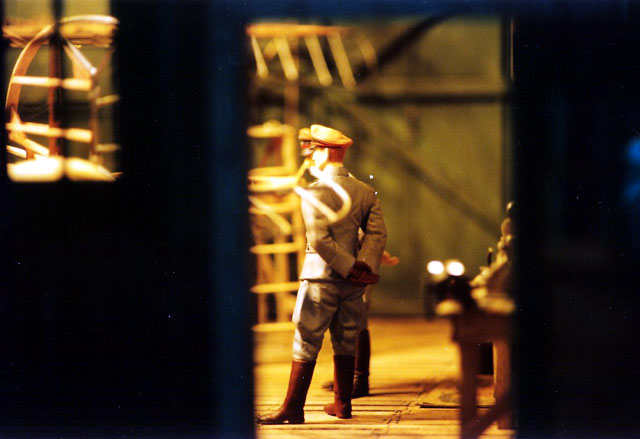
The figures were both glued and their feet pinned to the hangar floor.
Shepperd Paine thoroughly covers figure modification and figure painting
techniques in his book on “How to Build Dioramas”. Figures used were
Tamiya’s Rommel Kit 36305, Tamiya’s Luftwaffe Pilot Kit 36302 and Dragon’s
Signaler Kit 1608.
My primary objective in doing this diorama was to tell a story - to
capture a moment in time, to take the viewer back to a different era and
thereby create a three-dimensional work of art. It was my intention to
have the aircraft as the focal point. This is the reason why I left it in
pretty much pristine condition in contrast to the general griminess of the
hangar. All the figures are positioned looking towards the aircraft in a
relaxed stance in order not to draw attention away from the main subject.
The placement of the ladders, saw horses and furnishings is such that
nothing is placed 90o to each other. Try to avoid lining
things up in too much of an orderly fashion.
The diorama was lit much like a stage. The lighting emphasizes the
aircraft itself which downplays its surroundings.
The use of color should also be taken into consideration. Grey is a
neutral color and does not draw one’s attention. Red and green are
opposites on the artist’s color wheel and therefore can be used to create
color harmony.
In my work I am not a rivet counter, however I do
like to have lots of details to keep the piece interesting. I try to be
as accurate as possible, however I will use artistic licence for effect.
Before and during a project, a lot of my time is spent researching the
aircraft, hangar types, uniforms, tools, etc.
In retrospect, I am quite satisfied with the results of this, my first
aircraft diorama. Many thanks go to Shep Paine for his inspiration and to
Mark Miller for his wonderful website on the Albatros.
I am a retired pilot and flight operations officer.
I spent twenty eight years in aviation doing everything from sweeping
hangar floors to flying instructor.
In the 1960’s, I helped my father restore a full size 1929 Curtiss-Wright
Travelaire bi-plane D4D (CF-JLW) which now resides at the Reynolds Museum
in Alberta.
I have spent the last seventeen years in the visual arts, teaching
woodcarving and making decorative birds of prey sculptures.
During my working years, as a hobby, I constructed a 1/72” scale model of
H.M.S. Victory over a fifteen year period and 6,000 hours of shop time.
I have been married to the same women for 39 years as only she (Micheline)
could put up with me and my hobbies.
I presently have a Newport 28-1/16” diorama underway and am also working
on a Wright Brothers Flyer. I hear through the grapevine that Model
Airways has a 1/16” scale Jenny in mind, Hmmm! Now if I can only keep
this 62 year old body in shape!
Dedication
There is no glory in war but there is honor. This aircraft model is
dedicated to those airmen of all nations who fought honorably in aerial
battles of the past, in the hope that there will be no more.
Bibliography
·
Albatros Flighters in Action
Squadron/Signal Publications 46
1115 Crowley Drive
Carrollton, Texas 75006
·
Knights of the Air
Time-Life Books
541 North Fairbauks Court
Chicago Illinois 60611
·
How to Build Dioramas
Shepperd Paine
Kalmbach Books
·
How to Photograph Scale Models
Shepperd Paine and Lane Stewart
Kalmbach Books
References – Movie
·
The Blue Max
CBS/FOX Video
Industrial Park Drive
Farmington Hills, Michigan 48024
Sources – Models and Furnishings
v
Model Airways Kit MA 1001
Albatros DU
3850 North 29th Terrace, Suite 101
Hollywood, Florida 33020
v
Tamiya Kit 36305 Feldmarschall Rommel
v
Tamiya Kit 36302 German Luftwaffe Ace Pilot
Tamiya America Inc.
2 Orion
Aliso Viejo, California 92656
v
Dragon Kit 1608 Signaler
Dragon Models Ltd.
603-609 Castle Pear Road
Kow Nam Industrial Building
10/FL, B-1, Tsuen Waw, Hong Kong
v
Chrysnbon Stove Kit F260
Chrysnbon Inc.
P.O. Box 13
Western Springs, Illinois 60558
v
Multi-Minis Doll House CD Catalog
Hobby World
5450 Sherbrooke Street West
Montreal, Québec, Canada H4A 1V9
Sources – Internet
Mark Millers Museum Site
www.pilots-n-planes-wwl.com/
Virtual Art Museum
www.wwi-models.org
Holcomb’s Aerodrome
www.angelfire.com/va2/aerodrome/
Sources – Modeling Supplies
q
A + B Epoxy Paste
Hexcel Resin Chemicals
20701 Nordoff Street
Chatsworth, California 91311
q
Jo Sonja Acrylic Paint
Chroma Inc.
Lititz, Pensylvania 17543
q
Liquidex Gesso
Binney and Smith Inc.
Easton, Pensylvania 18044-0431
q
Spray Varnish
Flecto Co. Inc.
Oakland, California 94608
q
Carpenters’ Glue
Lepage’s Ltd.
Brampton, Ontario, Canada L6T 2J4
q
Prismacolor Permanent Markers
q
Sequin Pins
Symak Sales Co. Inc.
Montreal, Quebec, Canada H4R 1C1
q
Music Wire
K & S Engineering
Chicago, Illinois
Click the
thumbnails below to view larger images:
Model, Images and Text Copyright © 2003
by John Reid
Page Created 31 January, 2003
Last Updated
17 March, 2004
Back to
HyperScale Main Page |
Home |
What's New |
Features |
Gallery |
Reviews |
Reference |
Forum |
Search